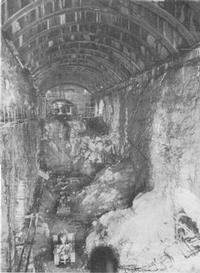


Chapter 6
I Construction During The Settlement Years
II The Use Of Timber As A Structural Material
III Structural Steel
IV Concrete Technology
V Housing
VI Industrialised Pre-cast Concrete Housing
VII Ports And Harbours
VIII Roads
IX Heavy Foundations
X Bridges
XI Sewerage
XII Water Engineering
i Pipelines
ii Tunnels
iii Dams
iv Power Stations
XIII Railways
XIV Major Buildings
XV Airports
XVI Thermal Power Stations
XVII Materials Handling
XVIII Oil Industry
XIX The Snowy Mountains Scheme
XX The Sydney Opera House
XXI The Sydney Harbour Bridge
XXII Hamersley Iron
XXIII North West Shelf
Sources and References
Index
Search
Help
Contact us

Power Stations
Hydro-electric power stations of many different types and arrangements have been built in Australia. The largest in capacity is currently the 1,500 MW Tumut 3 power station of the Snowy Mountains scheme, which was completed in 1972.Perhaps the most challenging engineering in power station construction so far encountered in Australia involved the Tumut 1 and 2 underground power stations of the Snowy Scheme. Although these were not the first underground stations to be constructed in Australia they were exceptional in the depth of the machine hall caverns beneath the surface (Tumut 1,340 m beneath and Tumut 2,200 m beneath). At this depth the rock is highly stressed and it was feared before construction that it might prove impossible to support the 23 m wide excavations.
The Snowy Mountains Authority therefore investigated the capabilities of rock-bolts for supporting large excavations (Lang 1958). Although rock-bolts had been in use in mines for some time they had previously been considered as useful only for pinning back isolated loose rocks. The investigations showed that a pattern of rockbolts in the roof of Tumut 1 would be quite capable of providing the necessary temporary support. Patterned rockbolting was introduced at Tumut 1, and the excavation was quickly completed without any rockfalls (Fig. 43).

Organisations in Australian Science at Work - Snowy Mountains Hydro-Electric Scheme
People in Bright Sparcs - Price, Douglas G.
 |
Australian Academy of Technological Sciences and Engineering |  |
© 1988 Print Edition pages 372 - 373, Online Edition 2000
Published by Australian Science and Technology Heritage Centre, using the Web Academic Resource Publisher
http://www.austehc.unimelb.edu.au/tia/373.html